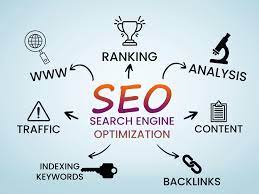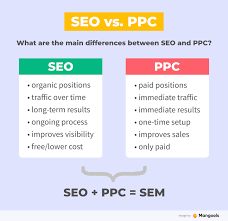Title: Unlocking the Power of SEO: Strategies to Improve Your Website’s Visibility
Introduction:
In today’s digital age, having a strong online presence is crucial for businesses and individuals alike. Search Engine Optimization (SEO) plays a vital role in improving your website’s visibility and driving organic traffic. By implementing effective SEO strategies, you can increase your chances of ranking higher on search engine result pages (SERPs) and reach your target audience more effectively. In this article, we will explore some key tactics to enhance your SEO efforts and boost your website’s performance.
Conduct Thorough Keyword Research:
Keywords are the foundation of any successful SEO strategy. Start by identifying relevant keywords that align with your content and target audience’s search intent. Utilize keyword research tools to find popular and low-competition keywords that can help you rank higher in search results.
Optimize On-Page Elements:
Optimizing on-page elements is essential for search engines to understand what your website is all about. Focus on optimizing meta tags, including title tags and meta descriptions, using relevant keywords naturally. Ensure that your content is well-structured, easy to read, and incorporates appropriate header tags (H1, H2, etc.).
Create High-Quality Content:
Content remains king when it comes to SEO. Develop informative, engaging, and original content that adds value to your audience’s lives. Incorporate targeted keywords strategically within the content while maintaining a natural flow. Remember to optimize images by using descriptive alt tags.
Build Quality Backlinks:
Backlinks from authoritative websites act as votes of confidence for search engines, indicating the relevance and credibility of your content. Focus on building high-quality backlinks through guest posting, influencer outreach, or creating shareable content that naturally attracts links from reputable sources.
Enhance Website Speed:
Website speed plays a significant role in user experience and search engine rankings. Optimize loading times by compressing images, minimizing code, and leveraging browser caching. A faster website not only improves SEO but also reduces bounce rates and increases user engagement.
Optimize for Mobile Devices:
With the increasing use of smartphones, optimizing your website for mobile devices is essential. Ensure your website is mobile-friendly, with responsive design elements that adapt to different screen sizes. Mobile optimization is not only crucial for user experience but also a ranking factor in search algorithms.
Leverage Social Media:
Social media platforms provide an excellent opportunity to boost your SEO efforts. Share your content across relevant social channels to increase visibility and encourage engagement. Social signals, such as likes, shares, and comments, can indirectly influence search engine rankings.
Monitor and Analyze Performance:
Regularly monitor your website’s performance using analytics tools like Google Analytics. Track key metrics such as organic traffic, bounce rate, conversion rate, and keyword rankings. Analyzing data allows you to identify areas for improvement and adjust your SEO strategies accordingly.
Conclusion:
Improving SEO requires a combination of technical expertise, strategic planning, and consistent effort. By implementing these strategies and staying up-to-date with the latest SEO trends and algorithm changes, you can enhance your website’s visibility in search results. Remember that SEO is an ongoing process that requires continuous optimization and adaptation to stay ahead of the competition. So start implementing these tactics today and unlock the power of SEO to drive organic traffic and achieve online success!
5 Frequently Asked Questions About Improving SEO in 2022
- How can I improve my SEO in 2022?
- How do I optimize my SEO content?
- How can I improve my SEO for free?
- What do you mean by SEO?
- Can you improve SEO yourself?
How can I improve my SEO in 2022?
Improving your SEO in 2022 requires staying up-to-date with the latest trends and best practices. Here are some key strategies to help you enhance your SEO efforts this year:
- Prioritize User Experience: Google’s algorithm increasingly focuses on user experience. Ensure your website is fast, mobile-friendly, and easy to navigate. Optimize your site’s structure, improve page load times, and provide valuable content that meets user intent.
- Core Web Vitals: Core Web Vitals are a set of metrics that measure the overall user experience of a website, including page loading speed, interactivity, and visual stability. Pay attention to these metrics as they have become ranking factors.
- High-Quality Content: Create well-researched, informative, and engaging content that satisfies user search queries. Focus on providing value to your audience while incorporating relevant keywords naturally.
- Featured Snippets and Voice Search Optimization: With the rise of voice search devices and featured snippets, optimize your content for voice queries by using conversational language and providing concise answers to commonly asked questions.
- Mobile-First Indexing: As mobile usage continues to grow, ensure your website is fully optimized for mobile devices. Implement responsive design, fast loading times, and a seamless mobile browsing experience.
- E-A-T (Expertise, Authoritativeness, Trustworthiness): Establish yourself or your brand as an authority in your industry by demonstrating expertise through high-quality content creation and obtaining backlinks from reputable sources.
- Local SEO: If you have a local business or target local customers, optimize for local search by creating Google My Business listings, acquiring positive reviews, and ensuring consistent NAP (Name, Address, Phone Number) information across online directories.
- Video Optimization: Leverage the power of video content by optimizing video titles, descriptions, tags, and transcripts for relevant keywords. Host videos on platforms like YouTube or embed them on your website.
- Technical SEO: Conduct regular website audits to identify and fix technical issues such as broken links, duplicate content, and crawl errors. Optimize your website’s structure, XML sitemaps, and robots.txt file to ensure search engines can easily crawl and index your pages.
- Social Media Integration: Social signals are not direct ranking factors but can indirectly impact SEO. Integrate social media into your marketing strategy to increase brand visibility, drive traffic, and encourage engagement with your content.
Remember, SEO is an ongoing process that requires continuous monitoring, adaptation, and optimization. Stay informed about industry changes, algorithm updates, and emerging trends to stay ahead in the ever-evolving world of SEO.
How do I optimize my SEO content?
Optimizing your SEO content is crucial to ensure that it ranks well on search engine result pages (SERPs) and attracts organic traffic. Here are some key steps to help you optimize your SEO content effectively:
- Research Relevant Keywords: Conduct thorough keyword research to identify the most relevant and popular keywords related to your content. Use keyword research tools to find keywords with high search volume and low competition.
- Incorporate Keywords Naturally: Once you have identified your target keywords, incorporate them naturally throughout your content. Place them in strategic locations such as the title tag, headings, meta description, and within the body of the content. However, avoid overstuffing keywords as it can negatively impact readability and user experience.
- Write High-Quality Content: Focus on creating informative, engaging, and original content that adds value to your audience. Write in a way that is easy to read and understand. Ensure that your content is well-structured with appropriate headings (H1, H2, etc.) and bullet points where applicable.
- Optimize Meta Tags: Pay attention to optimizing meta tags such as the title tag and meta description. Craft compelling titles that include relevant keywords and accurately describe the content of the page. Write concise and persuasive meta descriptions that entice users to click through from search results.
- Use Descriptive URLs: Create SEO-friendly URLs that include relevant keywords instead of using generic or random strings of characters. A well-structured URL helps search engines understand what the page is about.
- Optimize Images: Include relevant alt text for images using descriptive keywords that accurately describe what the image represents. This helps search engines understand the context of the image and improves accessibility for visually impaired users.
- Internal Linking: Incorporate internal links within your content to guide users to other relevant pages on your website. Internal linking helps search engines navigate and understand the structure of your website while also improving user experience.
- Improve Readability: Make sure your content is easy to read and digestible. Use subheadings, bullet points, and short paragraphs to break up the text. Consider using images, videos, and other visual elements to enhance the user experience.
- Mobile Optimization: Ensure that your content is optimized for mobile devices. With the increasing use of smartphones, mobile optimization is crucial for SEO success. Use responsive design elements that adapt to different screen sizes and ensure fast loading times on mobile devices.
- Regularly Update and Refresh Content: Keep your content fresh and up-to-date by regularly reviewing and updating it. Add new information, incorporate relevant keywords, and improve any outdated sections. Search engines favor websites that provide valuable and current content.
Remember that SEO optimization is an ongoing process. Continuously monitor your website’s performance using analytics tools to track keyword rankings, organic traffic, bounce rates, and other relevant metrics. By regularly analyzing data and making adjustments based on insights, you can continually optimize your SEO content for better visibility and improved rankings.
How can I improve my SEO for free?
Improving SEO doesn’t always have to come with a hefty price tag. Here are some effective ways to enhance your SEO for free:
- Conduct Keyword Research: Use free keyword research tools like Google Keyword Planner or Ubersuggest to identify relevant keywords for your content. Focus on long-tail keywords with lower competition and higher search volume.
- Optimize On-Page Elements: Ensure that your website’s meta tags, including title tags and meta descriptions, are optimized with relevant keywords. Use header tags (H1, H2, etc.) to structure your content and make it more readable for both users and search engines.
- Create High-Quality Content: Develop informative, engaging, and original content that provides value to your audience. Incorporate relevant keywords naturally within the content while maintaining readability. Remember to optimize images by using descriptive alt tags.
- Build Quality Backlinks: Reach out to other websites in your niche and offer guest posts or collaborations that can earn you backlinks. Participate in online communities and forums where you can share your expertise and link back to your website when appropriate.
- Optimize Website Speed: Improve loading times by compressing images, minifying code, and leveraging browser caching techniques. Google’s PageSpeed Insights tool can provide suggestions for optimizing your website’s speed.
- Ensure Mobile-Friendliness: With the majority of internet users accessing websites through mobile devices, it’s crucial to have a mobile-friendly site. Make sure your website has a responsive design that adapts well to different screen sizes.
- Leverage Social Media: Share your content across relevant social media platforms to increase visibility and drive traffic back to your website. Engage with your audience, respond to comments, and encourage social sharing of your content.
- Claim Your Business Listings: Register with online directories such as Google My Business, Bing Places for Business, and Yelp to ensure accurate information about your business is available online. This can improve your local SEO and help potential customers find you.
- Regularly Update and Optimize: Keep your website up to date with fresh content and regularly review and optimize existing pages. Monitor your website’s performance using free analytics tools like Google Analytics to identify areas for improvement.
- Research Competitors: Analyze what your competitors are doing well in terms of SEO and try to implement similar strategies while adding your unique value proposition.
Remember, while these strategies can help improve your SEO for free, investing in professional SEO services or premium tools may provide more advanced features and insights. However, implementing these free tactics consistently can still yield positive results for your website’s visibility in search engine rankings.
What do you mean by SEO?
SEO stands for Search Engine Optimization. It is the practice of optimizing a website or web page to improve its visibility and rank higher in organic (non-paid) search engine results. The goal of SEO is to increase the quantity and quality of website traffic by targeting specific keywords and optimizing various elements on the website to make it more appealing to search engines.
Search engines like Google, Bing, and Yahoo use complex algorithms to determine which websites should rank higher in search results. SEO techniques involve optimizing on-page elements such as meta tags, content, and site structure, as well as off-page factors like backlinks and social signals. By implementing effective SEO strategies, websites can attract more organic traffic from search engines and reach their target audience more effectively.
Can you improve SEO yourself?
Absolutely! Improving SEO is something you can do yourself with the right knowledge and tools. While it may seem overwhelming at first, there are several steps you can take to enhance your website’s SEO:
- Educate Yourself: Familiarize yourself with the basic principles of SEO, including keyword research, on-page optimization, link building, and technical SEO. There are numerous online resources, tutorials, and guides available to help you understand these concepts.
- Conduct Keyword Research: Use keyword research tools like Google Keyword Planner or SEMrush to identify relevant keywords for your content. Focus on long-tail keywords that have lower competition but higher search intent relevance.
- Optimize On-Page Elements: Ensure that your meta tags (title tags and meta descriptions) include targeted keywords and accurately describe your content. Use header tags (H1, H2, etc.) to structure your content and make it more readable for both users and search engines.
- Create High-Quality Content: Develop informative and engaging content that addresses the needs of your target audience. Incorporate relevant keywords naturally within the content while maintaining a conversational tone. Aim for originality and avoid duplicating content from other sources.
- Build Quality Backlinks: Seek opportunities to acquire backlinks from reputable websites in your industry or niche. This can be done through guest posting, reaching out to influencers or bloggers for collaborations, or creating shareable content that naturally attracts links.
- Improve Website Speed: Optimize your website’s loading speed by compressing images, minifying code, leveraging browser caching, and choosing a reliable hosting provider. A faster website not only improves user experience but also positively impacts SEO.
- Optimize for Mobile Devices: Ensure that your website is mobile-friendly and responsive across different devices and screen sizes. Mobile optimization is essential as search engines prioritize mobile-friendly websites in their rankings.
- Leverage Social Media: Promote your content on relevant social media platforms to increase visibility and drive traffic to your website. Engage with your audience, encourage sharing, and participate in relevant industry discussions.
- Monitor and Analyze Performance: Utilize analytics tools like Google Analytics to track key metrics such as organic traffic, bounce rate, conversion rate, and keyword rankings. Regularly analyze this data to identify areas for improvement and adjust your SEO strategies accordingly.
Remember that SEO is an ongoing process that requires continuous effort and adaptation. While it may take time to see significant results, consistent optimization will ultimately help improve your website’s visibility in search engine rankings.




